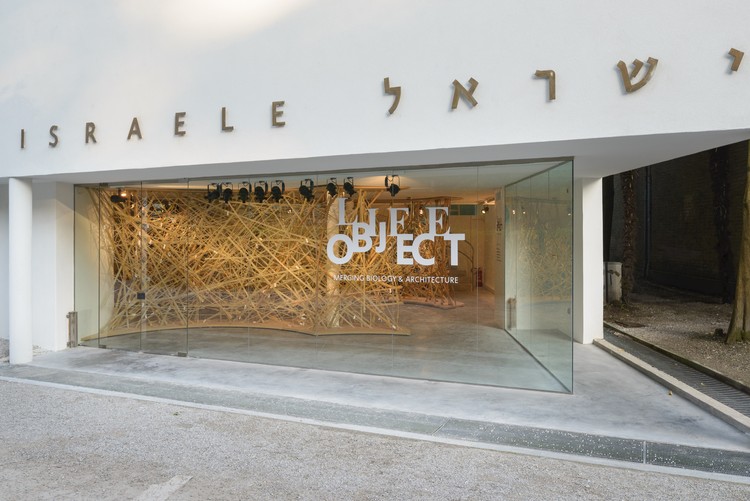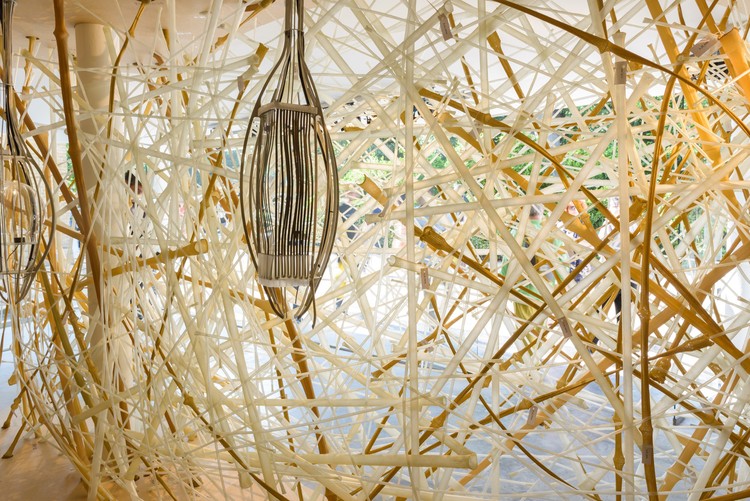.jpg?1464784448)
As part of ArchDaily's coverage of the 2016 Venice Biennale, we are presenting a series of articles written by the curators of the exhibitions and installations on show. Here, Arielle Blonder, one of the curators (along with Dr. Ido Bachelet, Bnaya Bauer, Dr. Yael Eylat Van-Essen and Noy Lazarovich) of the Israeli Pavilion, gives us an insight into one of the exhibited works in the pavilion: LifeObject, "a freestanding structure inspired by a 3D scan of a bird's nest." The essay was originally published in LifeObject: Merging Biology and Architecture.
A matter of resilience: LifeObject is an architectural installation, which transposes the resilient properties of a bird’s nest, through scientific analysis, into a spatial form rich with new architectural perspectives. At the core of the installation are free-form volumetric airy surfaces undulating in space that are composed out of over 1500 slender and light components, inspired by twigs; relying on tension only, they form a light-weight, porous and resilient structure. The LifeObject combines smart, composite and biological materials in the formation of a ‘living structure’ that responds to its environment. Human presence around it triggers the opening of ‘cabinet de curiosités’, revealing a variety of innovative biological elements to visitors.
The LifeObject materializes a series of abstract ideas, preoccupations and potentials in present and future architectural field. The concepts proposed by the structure sketch alternative formal and structural languages informed by external disciplines. It hints at future applications and integration of biologically inspired materials that originate from various settings, scales and orientation.

Starting from the study of a biological structure, The LifeObject spans across all levels of animation, from the bio-inspired design of inanimate material, through dynamic inorganic material, to living material itself. The LifeObject binds materials, technologies and alternative modes of design and fabrication in the creation of a complex system.
.jpg?1464784496)
New Materiality
The meaning of complexity in architecture has changed considerably in the past few decades, and in tandem, so has the manner with which we approach and treat complexity; the focus has shifted from visual formalism to a material perception of the world that deals with pragmatism, mechanisms of performance and processes of morphogenesis. This new position towards matter[1] serves as the backdrop for the LifeObject. It is tightly linked to the introduction of digital media into architecture in the mid-1990s, placing fabrication and generative design processes as core concepts of the architectural discourse. Computation, alongside concerns of sustainability, replaced compositions and semantics with matter and performance. New practices of material-making[2] that blur the boundaries between processes of digital fabrication, bring closer together design, fabrication and material research to take a central position in the architect’s work today[3]. The revisited approach to craftsmanship, especially as relates to new possibilities engendered by the development of digital fabrication as digital craft, adds another dimension to these new architectural preoccupations[4].
These new areas of architectural interest are not merely perceived as the expansion of his palette of expression, but rather as the contemporary understanding of his duty and professional responsibility[5]. As such, materials’ properties and their modes of transformation become motors of design, integrated as experimental research in material and fabrication; the architect now plays an active role in the development of materials and their making.
.jpg?1464784526)
[LifeObject] New matter
As an experiment of material research, The LifeObject evolved from the biomimetic study of a bird’s nest into a new material system[6]. Depending on its framing, the installation can be understood either as matter, as a structure or as system. We manipulated fiber-composite material to make components that are assembled into a structure, which in turn, when seen as a whole, can be regarded as a porous structural substance that makes free-form volumes in space. Extremely light, comprised of a multitude of similar but varied components of low material density, it creates a stable yet flexible, resilient volumetric matter. In a process of learning through the material, rather than by a parametric control over it to achieve performance, matter becomes a generative force[7] that informs the design and its construction processes, as modes of material making. Rather than integrating biological principles within a mechanical framework, as a typical biomimetic process, we wish to embrace biological values across all levels, not only in its design but also in the design process and construction method. Abandoning deterministic control for an open-ended fabrication and construction process that is attentive to the qualities of this new matter-structure is the essential shift we have made towards the adoption of the biological paradigm within architecture.
.jpg?1464784576)
[LifeObject] A matter of biology
This new materiality that we are presenting with The LifeObject is the product of dialogue between architecture and biology. A possible approach to portrait it is through common biological characteristics, suggesting that we can read The LifeObject as a biological material and a living organism.

The richness of natural materials and living organisms can be characterized by several common traits[8], which by and large stand in contrast to the mechanically engineered world; bottom up processes of growth contrast top-down traditional design approaches, multifunctionality diverges from optimized efficiency and the biological adaptive qualities can be seen as the absolute opposite of planning and control. These deep concepts of design and operation constitute the core of living materials and indicate the biological qualities of The LifeObject. It is structured as a hierarchical material*, building up from the fiber, through the knit surface, to the overall spatial aggregation that makes up the volumetric porous elements. A strong interrelation between all hierarchical levels directly affects the overall performance of the material. The fundamental natural process of self-organization* is reflected on several levels of hierarchy, implemented through processes of design, fabrication and assembly. The knit material finds it form by gravity to make the components, which in turn are assembled following a design code that combines randomness with preset values; these derive from the algorithmic analysis of the nest. Just as the distinct form of the bird’s nest emerges from the random arrangement of twigs under mutual bending stresses, the overall form of the LifeObject is achieved by the adaptivity* of its structure. Its free-form shape results from the mutual bending forces of its components, pressed between floor and ceiling. On the component level, its morphology is the outcome of its adaption to gravity forces and boundary conditions. The mold-free fabrication process through which the components were made exemplifies low-energy synthesis*, echoed in the joint-free construction process. As a multifunctionalmaterial, it combines structure with the functional elements of the ‘breathing cells’, into an integral system.
Taking “the indifference to one’s surrounding”[9] as the distinctive element between the living and the non-living, as a kind of re-visited vitalism, opens-up the possibility of regarding The LifeObject with its integrated breathing cells, as a living system. Concepts such as movement, feedback and intelligence that distinguish the living from the inanimate, demonstrate The LifeObject‘s hybrid nature. It comes to life providing a kind of feedback* to human presence, activating both structure and space. ‘Pores’ in the structure open up to reveal biological wonders, and translucent glass surfaces in space change opacity to expose the outdoor natural setting. The opening of the ‘pores’ is facilitated by stripes of shape-memory material that form a moving screen. Programmed changes in molecular organization of the material create a non-mechanical movement*. The dynamic behavior of shape-memory materials acts as a material embedded motor, as a kind of material intelligence. The potential future integration of biological materials within the system, insinuated by the living matter displayed within the ‘pores’, bears the promise of a enhanced material intelligence, which merges architectural materiality with the biological one.
.jpg?1464784772)
[LifeObject] A matter of resilience
The different characteristics of TheLifeObject, reflected in its design, fabrication and behavior, relate it to living systems and biological materials. Standing in contrast to the architectural-mechanical paradigm, it is the system’s natural properties that make-up its resilient nature.
In the same way that the redundancy of twigs in the bird’s nest builds its resistance, the multitude of light and weak elements that compose The LifeObject enhance its robustness. The final stability of the structure is reached by the multiple interactions between the elements as points of friction, contributing to its overall resilient nature.
“Diverse at its edge, while simple at its core”[10], it is the slight variation within the wide array of similar yet individual components that ensures the resistance of the structure to failure. Its design and construction, that combines the pre-determined and the emergent, makes it insensitive to local errors and minor deficiencies.
The bird’s nest, as an iconic natural model of a home, was intentionally chosen for the longtime interest this structure has raised amongst architects and engineers in various perspectives, from the Beijing 2008 stadium of Herzog and De Meuron, to its CT scanning and computation as part of the Emergent Technologies and Design program[11]. For us, the starting point for the questioning of relationships between the artificial and the natural in the future built environment had to be the home. From there, through an experimental process of algorithmic analysis, coding, material research, alternative fabrication and design, The LifeObject has evolved to become a new matter of resilience.
[1] See the elaboration of these terminologies in the phrasebook terms intecalated in the following LifeObject section. For a more elaborate discussion on the philosophical aspects of the new approach to materiality see opening text by Y.Eylat Van-Essen “LifeObject, Merging Biology and Architecture"
[2] A leading example of bio-inspired material making by digital fabrication tools of rapid prototyping is the work of Neri Oxman with Variable Properties Rapid Prototyping (VPRP). See for example Neri Oxman, “Variable Property Rapid Prototyping.” Virtual and Physical Prototyping 6, no. 1 (March 1, 2011): 3–31.
[3] For a review of different approaches to material based computational design see Rivka Oxman, “Informed Tectonics in Material-Based Design.” Design Studies 33, no. 5 (September 2012): 427–55.
[4] See for example architectural explorations of digital fabrication in the works of Marc Fornes at https://theverymany.com/, Andrew Kudless at http://matsysdesign.com/ and Lisa Iwamoto, Digital Fabrications: Architectural and Material Techniques. New York: Princeton Architectural Press, 2009
[5] Thomas Schröpfer, Material Design: Informing Architecture by Materiality. Basel: Birkhäuser GmbH, 2010.
[6] Material system describes “… the complex reciprocity between materiality, form, structure and space, the related processes of production and assembly and the multitude of performative effects that emanate from the interaction with environmental influences and forces” and is extensively researched by Michael Hensel, Achim Menges, and Michael Weinstock. Emergent Technologies and Design: Towards a Biological Paradigm for Architecture. Oxon, U.K. ; New York, NY: Routledge, 2010. P. 48
[7] Theorizing the new understanding of matter as possessing morphogenetic powers of its own through a revisited approach to causality, space and structure see Manuel DeLanda, “The New Materiality.” Architectural Design 85, no. 5 (September 1, 2015): 16–21. doi:10.1002/ad.1948.
[8] An example for the characterization of biological materials can be found in the work of Marc Meyers, for example in: Marc A. Meyers, and Po-Yu Chen. 2014. Biological Materials Science: Biological Materials, Bioinspired Materials, and Biomaterials. 1 edition. New York: Cambridge University Press.
[9] Catehrine Ingraham “Why all these birds? Birds in the sky, birds in the hand”, in Architecture and the Sciences: Exchanging Metaphors. Alessandra Ponte and Antoine Picon. 20031 edition. New York, N.Y. : Princeton, N.J: Princeton Architectural Press. P. 238
[10] Andrew Zolli, and Ann Marie Healy. Resilience: Why things bounce back. Simon and Schuster, 2012.
[11] Ibid 6, p.21



.jpg?1464784448)
.jpg?1464784576)
.jpg?1464784772)
.jpg?1464784752)
.jpg?1464784496)
.jpg?1464784817)
.jpg?1464784704)
.jpg?1464784678)
.jpg?1464784647)
.jpg?1464784596)
.jpg?1464784526)
.jpg?1464784442)

